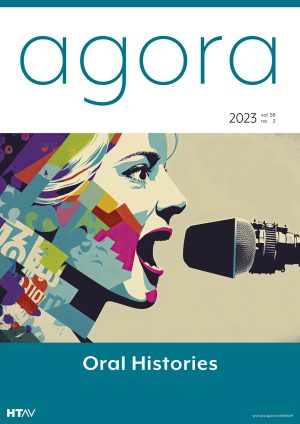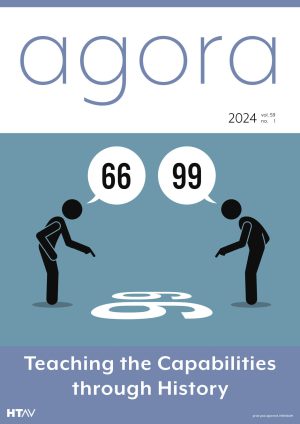Contents
Reflection| Elisa Litvin
Editorial | Guy Nolch
THEMA | Reflections on the theme
A Guide to the Australian Framework for Generative Artificial Intelligence in Schools | Leon Furze, Deakin University
The federal government’s framework provides valuable guidance for History teachers about the use of generative AI in the classroom.
Artificial Intelligence and the Future of Education | Ian Lyell, Mentone Girls’ Grammar School
In a world of increasing automation, teachers must equip students with critical thinking skills that enable them to do what AI cannot.
How Artificial Intelligence Is Redefining the Concept of Knowledge | Sarah V. Bentley and Raj Burli, Data61, CSIRO
AI is a disruptive technology that can shed light on important societal issues, such as where knowledge comes from, how it impacts thoughts, attitudes and behaviours, and how we can trust it.
‘Here, Ready or Not!’: Teaching History in an AI World | Vince Wall, All Hallows’ School, Brisbane
Like the internet before it, artificial intelligence is already an omnipresent force that educators must embrace to ensure that their students remain active learners who don’t relinquish their voice to automation.
The Next Word on AI in History Education | Matthew Esterman, Our Lady of Mercy College Parramatta
Generative AI poses ethical, legal and social risks that need to be addressed and managed by school leaders, teachers and students.
Cultivating Transferable Skills in AI-enhanced Teaching | Felicitas Hartung and Rachel Emerine Hicks, University of California San Diego
Teaching and learning through AI individualises learning processes and streamlines workflow from lesson planning to grading.
AI Apps that Enhance History Teaching | Rachael Patrick and Anam Javed, Victorian Academy of Teaching and Leadership
Several AI tools can help History teachers reduce their administrative loads, adapt content for different learning needs and increase student agency and engagement.
The Question of Bias in AI Outputs | Nyree Wilson and Jett Wickes, Dandenong High School
Since the internet has some questionable biases related to gender, ethnicity and social class, students need to interrogate how these are reflected by AI outputs generated.
Indigenous Considerations of the Potential Harms of Generative AI |Tamika Worrell and Dorothy Johns, Department of Critical Indigenous Studies, Macquarie University
It is integral to consider the ways in which generative artificial intelligence replicates settler-colonial violence by perpetuating misinformation and disinformation about Indigenous peoples.
Teaching the Limitations of AI as a Writing Tool |Scott Hetherington, Virtual School Victoria
A six-week program can teach History students how to identify where AI-generated responses to essay questions fall short, and critique their own work as well.
Is the History Essay Dead? | Adrian Cotterell, Emmaus Christian College
Generative AI has changed the world, and with it our expectation of when and where summative essays can be completed, as well as when new AI-powered assessment methods should be used instead.
PRAKTIKOS | Teaching Ideas
Creative Uses of AI for History Teachers | Ben Lawless, Aitken College
History teachers can use generative AI in many creative ways, including brainstorming ways to make History classes more engaging.
Revolutionising History Education: The Power of Generative AI for Teachers | Kane Pittard, Balga Senior High School
Well-written prompts, customised ChatGPT settings and graphical reconstructions of open access data can unleash the full potential of AI in the History classroom.
Prompt Engineering to Harness Generative AI Tools | Anam Javed and Rachael Patrick, Victorian Academy of Teaching and Leadership
A simple acronym and checklist can help teachers develop prompt engineering skills to create differentiated learning tasks.
AI Tools to Enhance Teaching and Reduce Workloads | Matthew McLean, Mount Clear College
Tools like Almanack and MagicSchool can streamline lesson planning and differentiation, while Quizizz can quickly create interactive quizzes that reinforce key concepts in an engaging way.
Creating AI Characters of Historical Figures | Lynne Telfer, Wyndham Tech School
Inworld enables students to create AI-generated characters based on historical figures, making it easier for students to connect and empathise with people of the past.
Tackling the Reliability of AI-Generated Images as Historical Sources | Joy Ashwell Callaway, Shelford Girls’ Grammar
New source analysis techniques are needed to determine which online images are real and to what extent AI-generated images accurately portray the past.
Digital Maps Reveal How the Gold Rush Devastated the Ballarat Environment | David Waldron, Federation University
The gold rush devastated the western Victorian landscape and ravaged a traditional way of life that had remained unbroken for millennia. A new digital heritage project allows people to explore the sheer enormity of that environmental and cultural transformation.
KRITIKOS | Reviews



